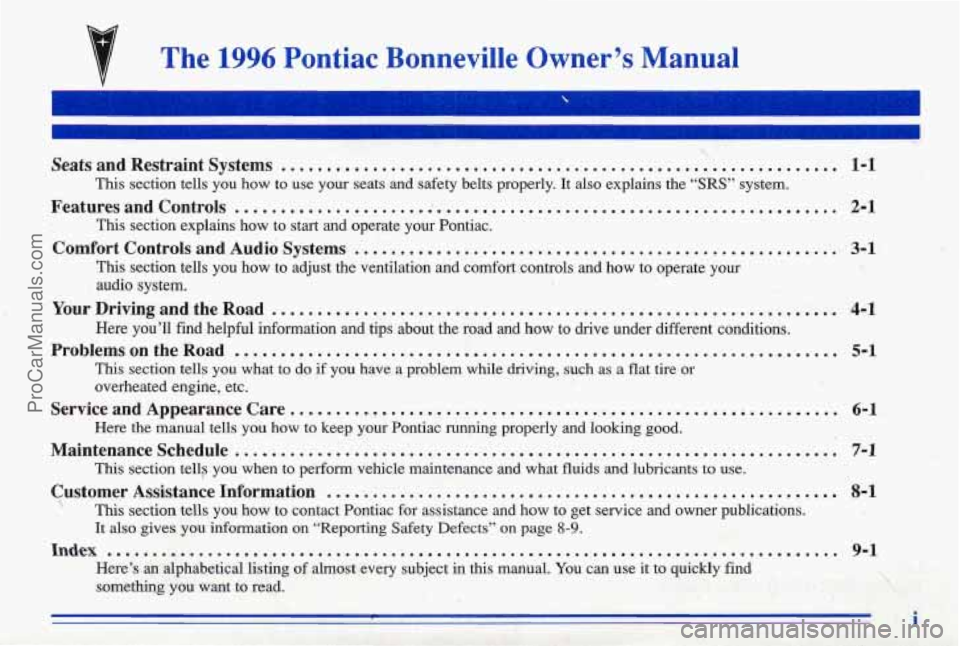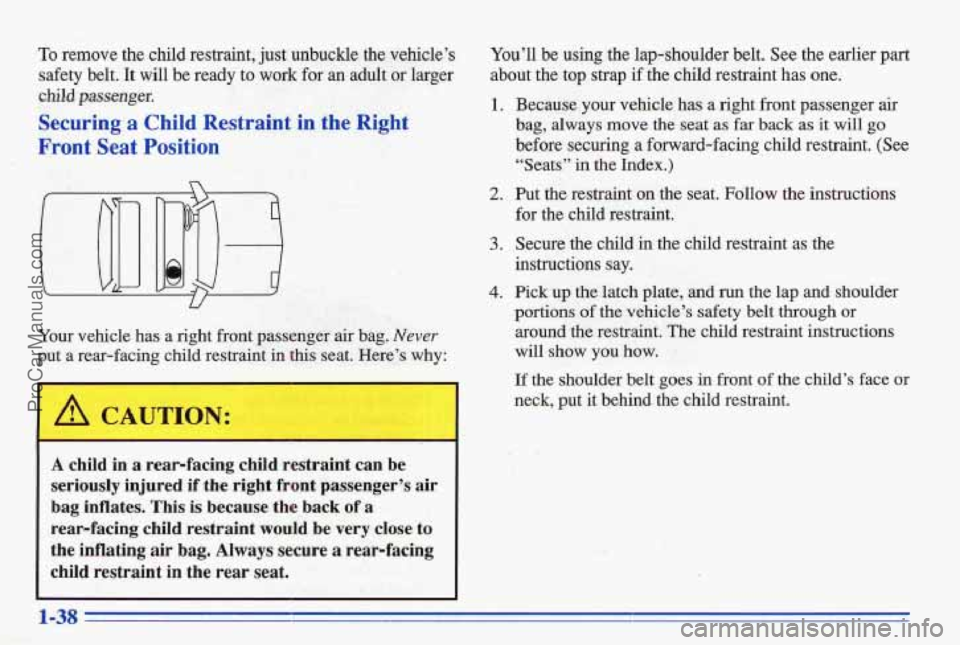Page 2 of 387

The 1996 Pontiac Bonneville Owner’s Manual
-
Seats and Restraint Systems ............................................................. 1-1
This section tells you how to use your seats and safety belts prop\
erly. It also explains the “SRS” system.
This section explains how to start and operate your Pontiac.
This section tells you how to adjust the ventilation and comfort co\
ntrols and how to operate your
audio system.
Here you’ll find helpful information and tips about the road\
and
how to drive under different conditions.
This section tells you what to do if you have a problem while driving, such as a flat tire or
overheated engine, etc.
Here the manual tells
you how to keep your Pontiac running properly and looking good.
This section tellp you when to perform vehicle maintenance and what \
fluids and lubricants to use.
This section tells you how to contact Pontiac for assistance and how to get service and \
owner publications.
It also gives you information on “Reporting Safety Defects”\
on page 8-9.
Here’s an alphabetical listing of almost every subject in this manual. You can use it to quickly find
something
you. want to read.
Features and Controls ..................... ; ............................................ 2-1
Comfort Controls and Audio Systems ...................................................... 3-1
. Your Driving and the Road .............................................................. 4-1
ProblemsontheRoad
.................................................................. 5-1
Service and Appearance Care.. .......................................................... 6-1
Maintenanceschedule......... .......................................................... 7-1
Customer Assistance Information ... .#. ................................................... 8-1
Index ........................................................................\
.......... 9-1
ProCarManuals.com
Page 8 of 387
Section, 1 Seats and -Restraint Systems
~~~~
Here you’ll find information about the seats in your Manual Front Seat
Pontiac and how to use your safety belts properly. You ~~ ._ can also learn about some thkgs you should not do with
air bags and safety belts.
Seats and Seat Controls
t ,. :’ This section,tells you about the seats -- how to adjust
them
-- and also about reclining seatbacks and head
restraints.
I
A CAUTION:
You can lose control of the vehicle if you try to
adjust a manual driver’s seat while the vehicle is
moving. The sudden movement could startle and confuse
you, or make you push a pedal when you
don’t want to. Adjust the driver’s seat only when
the vehicle is not moving.
Pull up on the control bar under the front of the seat to
unlock it. Slide the seat to where you want it. Then
release the bar and
try to move the seat with your body,
to make sure the seat is locked into place.
1-1
ProCarManuals.com
Page 9 of 387
Power Seat (Option)
To adjust the power seats on
some mkls: ,
Front Control (A): Raise the front of the seat by
holding the switch up. Lower the front of the seat by
holding the switch down.
Center Control (B): Move the seat forward by pressing
the control forward, or backward by pressing the control
backward.
Move the seat higher
by holding the control up. Lower
the ,seat
by holding the control down.
Rear Control (C): Raise the rear of the seat by holding
the switch
up. Lower the rew of the seat by holding the
switch down.
Power Lumbar Controls (Option)
d! Reshapes the lower back area of the seat.
& Reshapes the middle back kea of the seat.
mk Reshapes the upper back area of the seat.
ProCarManuals.com
Page 17 of 387
Driver Position
This part describes the driver’s restraint system.
Lap-Shoulder Belt
The driver has a lap-shoulder belt. Here’s how to wear
it properly.
1. Close and lock the door.
2. Adjust the seat (to see how, see “Seats” in the Index)
so you can sit up straight.
3. Pick up the latch plate and pull the belt across you.
4. Push the latch plate into the buckle until it clicks.
Don’t let
it get twisted.
Pull up on the latch plate to make sure it is secure.
If the belt isn’t long enough, see “Safety Belt
Extender” at the end
of this section.
Make sure the release button on the buckle is
positioned
so you would be able to unbuckle the
safety belt quickly if you ever had
to.
1-10
ProCarManuals.com
Page 30 of 387
Center Passenger Position
Lap Belt
If your vehicle has front and rear bench seats, someone
can sit in the center positions. When you sit in a center seating position, you have a lap
safety belt, which has no retractor.
To make the belt
longer, tilt the latch plate
and pull it along the belt.
ProCarManuals.com
Page 45 of 387

To remove the child restraint, just unbuckle the vehicle’s
safety belt.
It will be ready to work for an adult or larger
child passenger.
Securingta Child Restraint in the Right
Front Seat Position
Your vehicle has a right front passenger air bag. Never
put a.rear-facing child restraint in this seat, Here’s why:
A child in a rear-facing child restraint can be
seriously injured if the right front passenger’s air
bag inflates.
This is because the back of a
rear-facing child restraint would be very clos’e to
the inflating air bag. Always ‘secure a rear-facing
child restraint
in the rear seat.
You’ll be using the lap-shoulder belt. See the earlier part
about the
top strap if the child restraint has one.
1. Because your vehicle has a right front passenger air
bag, always move the seat as far back as it will go
before securing a forward-facing child restraint. (See
“Seats”
in the Index.)
for
the child restraint.
2. Put the restraint on the seat. Follow the instructions
3. Secure the child in the child restraint as the
imtructipns say.
4. Pick up the latch plate, and run the lap and shoulder
portions of the vehicle’s safety
belt through or
around the restraint. The child restraint instructions
will show you how.
If the shoulder belt goes in front of the child’s face or
neck, put
it behind the child restraint.
1 ?Q
ProCarManuals.com
Page 72 of 387
Automatic Transaxle Operation
Your automatic transaxle may have a shift lever
located on the console between the seats or on the
steering column.
There are several different positions for your shift lever.
PARK (P): This locks your front wheels. It’s the best
position to use when you start your engine because your
vehicle
can’t move easily. It
is dangerous to get out of your vehicle if the
shift lever
is not fully in PARK (P). with the
parking brake firmly set. Your vehicle can roll.
Don’t leave your vehicle when the engine
is
running unless you have to. If you have left the
engine running, the vehicle can move suddenly.
You or others could be injured.
To be sure your
vehicle won’t move, even when you’re
on fairly
level ground, always set your parking brake and
move the
shift lever to PARK (P).
See “Shifting Into PARK (P)” in the Index. If
you’re pulling
a trailer, see “Towing a Trailer” in
the Index.
2-21
ProCarManuals.com
Page 144 of 387

If you have the rear seat passenger outlet, it's attached to
the back
of the console. You can adjust the airflow
toward either seating area, the floor or upward. Turn the
end
knobs up and down to direct airflow. Increase or
reduce
the amount of airflow by opening and closing the
louvers. Opening and closing the louvers will also direct airflow from side-to-side.
Ventilation Tips
0 Keep the hood and front air inlet free of ice, snow or
any other obstruction such as leaves. The heater and
defroster will work better, reducing the chance of
fogging your windows.
0 When you enter a vehicle with the standard system in
cold weather, select
HEATER to supply air through the
floor outlets. Then
turn the fan on high for a few
moments before driving away. This will blow moist air
from the intake outlets toward the floor, not the
windshield. It reduces
the chance of fogging your
windows. If you have the electronic system, the AUTO
setting will do this for you. Manual operation of the
electronic system in the
HEAT' mode will also supply
air through the floor outlets.
0 Keep the air path under the front seats clear of objects.
This helps air to circulate throughout your vehicle.
0 When the engine idles for a long time, the exterior
temperature sensor may cause the system to blow
air
that is too cool. Once the vehicle is moving again the
system will
try to maintain the set temperature inside
your vehicle.
display flashes (electronic system only) for some time,
the system may need repair. See
your Pontiac dealer.
/
0 When you start your vehicle and the EXT TEMP
ProCarManuals.com